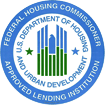Owning a home is a dream for some and a need for many. A dream home symbolizes beauty and luxury. For people that need a home for shelter, it keeps them safe. Now both the housing dream and the need for shelter can be easily fulfilled, thanks to the Federal Housing Administration (FHA) and United States Department of Agriculture (USDA), two government agencies that make home loans more affordable. The key to your housing dream is FHA home loans and USDA mortgage loans. An FHA home loan is backed by the U.S. Department of Housing and Urban Development (HUD), which was formed to make homeownership attainable for more people in the United States. The USDA mortgage loan is designed to help families purchase homes in a rural setting. Both loans are highly beneficial, yet have some key differences.

How FHA Home Loans Are Different from USDA Mortgage Loans
Below is a list that'll help you understand how FHA home loans are different from USDA mortgage loans.
1. Down Payment
The biggest concern for a homebuyer when planning to buy a home through a home loan is the down payment. Both FHA and USDA home loans have relaxed down payment benefits. FHA loans require a down payment of a minimum percentage of the total purchase price, whereas USDA home loans don’t require any down payment.
2. Closing Costs
A seller is required to bear some percentage of the closing costs for both FHA and USDA loans with the remaining amount to be paid by the buyer. In FHA loans, the maximum loan amount is inclusive of closing costs and cannot exceed a defined percentage. Whereas, in a USDA loan, the borrower can get a loan amount equivalent to the appraised value of the home. The loan amount you may borrow in a USDA loan is much more than an FHA loan.
3. Credit Score
Both FHA and USDA loans are liberal on credit scores and much more forgiving than conventional loans. FHA loans require a minimum credit score to qualify. You may also need to pay a minimum down payment if it falls into a particular credit score range. The best thing about USDA loans is that you don’t have to worry about the minimum credit score and they work with any borrower who can show that they can afford the new loan.
4. Area Limits
There are no geographic area restrictions for purchasing a property through FHA loans. This means you can buy a property that is located anywhere (not confined to a particular area). USDA loans are available only for those properties that are located in an area qualified as rural or semi-urban by the USDA. You may be surprised to know that the place you may be living may come under rural or semi-urban location.
5. Income
In the case of FHA loans, the more income you make, the better the loan term. A person earning higher income usually means a lower debt-to-income ratio. This denotes that you’re a lower risk for the mortgage lender. On the other hand, the USDA loan is designed for those borrowers that don’t have a higher income. This loan is targeted to low to middle-income brackets. USDA mortgage loans aim to build up rural areas for families who have lower income, rather than to provide a loan with no down payment.
If you’re looking for a mortgage lender in MA to help you identify the differences between FHA home loans and USDA mortgage loans, then Drew Mortgage Associates can help! Drew Mortgage Associates is a Boston mortgage lender that helps you identify an ideal mortgage loan that best fits your finances. Our home loan officers can assist you with mortgage programs that offer low-interest rates, low down payments, and reduced loan terms.



